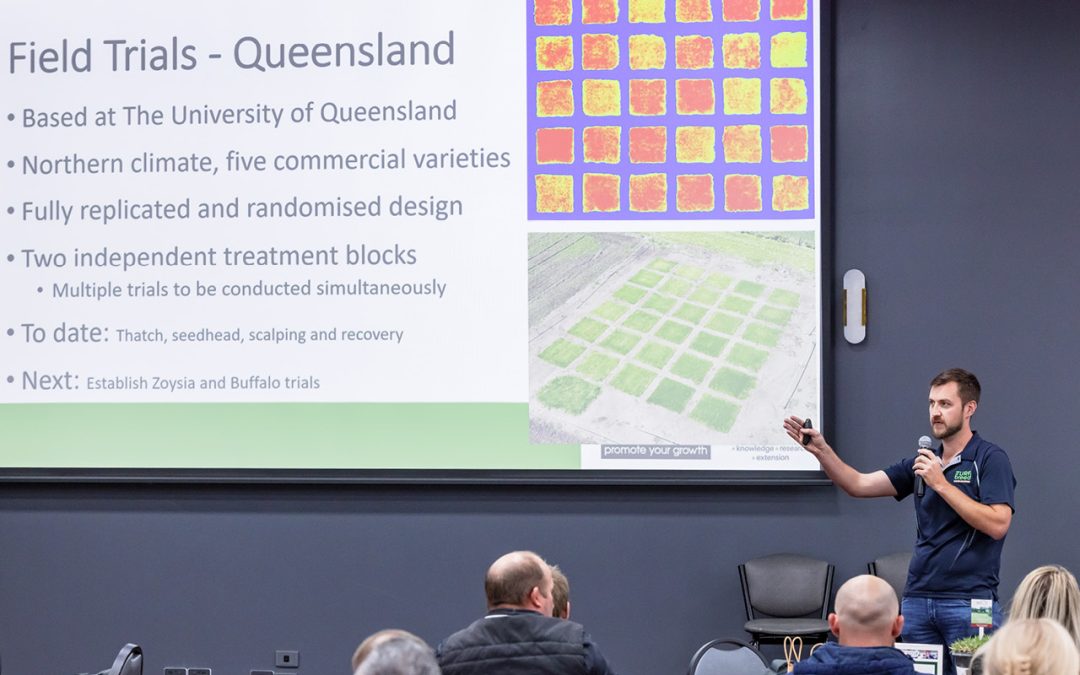Research trials testing the performance of new and existing turf varieties are being expanded in both Queensland and Victoria.
Senior Research Scientist Dr Andrew Fletcher, who co-ordinates the national research and development program, said TurfBreed’s newest variety, IronCutter™ Elite Hybrid Bermudagrass was already shining in field trials at the Turf RnD Facility at the University of Queensland (UQ).
But he’s also excited by the prospect of expanding trials at the site to learn more about TurfBreed’s existing collections of Buffalo and Zoysia grasses, putting them through their paces in similar studies of water use and drought and shade tolerance in collaboration with UQ researchers.
Andrew said the main purpose of the initial IronCutter™ trials was to investigate thatch, seed head production, wearability and recovery from scalping.
The replicated and randomised trials included six plots each of five varieties: IronCutter™, Tahoma 31, TifTuf, Wintergreen and Santa Ana.
NDVI images were used to measure how much healthy green leaf material was present before and after mowing with a small tractor towing a flower mower.
Material was raked up to measure it in cubic metres per square metre, and a golf hole cutter used to pull up plugs and measure the depth of thatch in the centre of the core.
Findings so far include significant differences. IronCutter™ was consistently the darkest green colour, produced a deep and well-developed fibrous root system, generated the lowest thatch layers over six months and showed the greatest tolerance to scalping along with the fastest recovery.
Andrew said some of the differences could be attributed to the tendency of IronCutter™ to maintain more green leaf throughout the entire canopy.

“IronCutter™ has a more upright, vertical leaf, allowing more light into the canopy, so lower leaves don’t die and contribute to thatch accumulation,” he said.
“What we’ve heard from the people who’ve tried IronCutter™, a lot of them say it’s different, it’s better and a lot of people are liking what they see with it.”
Measurements also showed IronCutter™ has a much higher ratio of roots to above ground material which should benefit the grass by storing more energy and allowing it to tolerate more wear.
Andrew said this should also result with it being able to “hold together better on a slab or in a playing surface”.
 A similar trial will be run at the Victorian trial site at the Yarra Bend Golf Course using the same five varieties, but also looking at different cutting heights.
A similar trial will be run at the Victorian trial site at the Yarra Bend Golf Course using the same five varieties, but also looking at different cutting heights.
“This is going to give us a nice comparison between Queensland, which is a much more tropical environment, and Melbourne, and give us some good data to put out to growers and consumers down there,” he said.
IronCutter™ also is being tested with small-scale plantings in residential lawns, a park on the Sunshine Coast, and at Brisbane Golf Club on several tees, greens and the wedding venue, Jacaranda Gardens.
“We want to see how it actually copes with real world experience,” Andrew said.
“You can have all the data you like, but if it doesn’t actually hold up, it’s no good, so we’re really trying to get some meaningful demonstrations of how this grass works.
“In the next 6-12 months we’ll be keen to replicate the process with Gateway Zoysia and get that rolled out.”
On the road again
In other research trials, a 70 metre long section of roadside has been used to demonstrate the benefits of planting a Zoysia rather than a Couch or native grass.
The plots of Empire Zoysia, Nara™ Zoysia, Stadium® Sports Couch, OZTUFF® Couch and the natural Rhodes grass, were planted beside a farm road at Boyland in Queensland during April 2022. They were left unmowed from May 2022 and received no fertiliser or irrigation.
“Over a period of about a year the Couch wasn’t too bad, but the Zoysias got to about half its height and Rhodes grass got up to about 1m,” Andrew said.
“For those approaching councils and people doing civil works to promote the benefits of Zoysias – you can tell them ‘Yes, this grass might cost a bit more upfront, but you’ll be spending less money by mowing less often’.”
Andrew said the trigger point for mowing by most councils was 20-30cm, but the zoysia grasses weren’t even close to reaching that height after 12 months.

Assessments also were made of turf quality and seed head production, another common trigger for mowing.
In December 2022, the Zoysias and Couch were even for turf quality, but by May this year the Zoysias had achieved 1.6 to 2.3 times the quality of Couch.
Seed head ratings for the Zoysias were almost a quarter lower than Couch in December, falling to 73 per cent lower for Nara™ Zoysia and 60 per cent lower for Empire Zoysia.
The natural Rhodes grass was tallest of the plots at each assessment date and consistently recorded a higher seed head rating and lower turf quality.
Andrew said future trials would be designed to collect the full range of data on all TurfBreed varieties.
“The work with IronCutter™ has been really interesting for us,” he said.
“It’s a good foot in the door to make sure we’re doing it right before we jump all the way in. We’re now at a point where we’re ready to go all in with everything, including doing more drought studies.”
Andrew said drought and water use was a hot topic for the turf industry, so it was important to have scientific studies to demonstrate how much water each variety used in order to combat false information.
The trend towards bigger houses on smaller housing blocks with taller fences in new subdivisions also made it necessary to run new tests on shade tolerance so up to date information could be provided to customers, he said.

